日常交易无需 USB 线,以 App 驱动,硬件钱包赛道少有的「移动端优先」架构。
撰文:Tyler
当下,想要获得硬件钱包级别的 Crypto 安全保障,门槛最低是多少?
在硬件钱包市场中,用户常常需要在「易用性」与「性价比」之间达成权衡,像海外老牌厂商 Ledger、Trezor 因使用体验而长期饱受诟病,华语区用户更熟悉的 OneKey 性价比又不如往昔,硬件钱包似乎普遍陷入「安全即笨重」的行业困局。
值得注意的是,作为币安最早孵化,也是目前唯一被币安投资过且上线币安 Launchpad 的硬件钱包项目,SafePal 将硬件钱包的入门门槛降至 49.9 美元,同时将签名、授权等高频操作迁移至手机端,仅在固件升级、充电等低频场景使用 USB 接口,并构建起了硬件钱包(S1、S1 Pro 和 X1)、软件钱包、浏览器插件钱包和合规银行服务的全栈体验。
本文就将聚焦 SafePal 的硬件钱包全家桶,结合实际体验与全系横评,尝试拆解 SafePal 如何用「移动端优先」的思路,日常交易(授权/签名)零接触通信,固件升级/充电保留物理接口,在「安全」与「便捷」的博弈中找到破局点,为普通用户打开硬件钱包的「轻量级安全」大门。
SafePal 硬件钱包全家桶:S1、S1 Pro、X1
目前 SafePal 硬件钱包产品线共涵盖三款机型:S1(49.99 美元)、S1 Pro(89.99 美元)、X1(69.99 美元)。
其中 S1、S1 Pro 采用二维码交互形式,通过摄像头扫码与手机端 SafePal 钱包 App 配对,做到全程物理隔离;X1 则主打蓝牙低功耗连接,可通过蓝牙与手机 App 配对,兼顾便捷性与安全性,更适合频繁操作的 Degen 用户。
这三款硬件钱包均已完成审计并在 GitHub 开源,可设置 PIN 及 PassPhrase,且出厂自带防黑客自毁机制、设备防伪验证、固件防篡改保护,能与 SafePal App 及 SafePal 插件钱包搭配使用,全面支持 iOS、Android、Windows 及 MacOS,并覆盖 App 端的 200 多条公链及所有链上的币种、NFT 及智能合约资产管理需求。
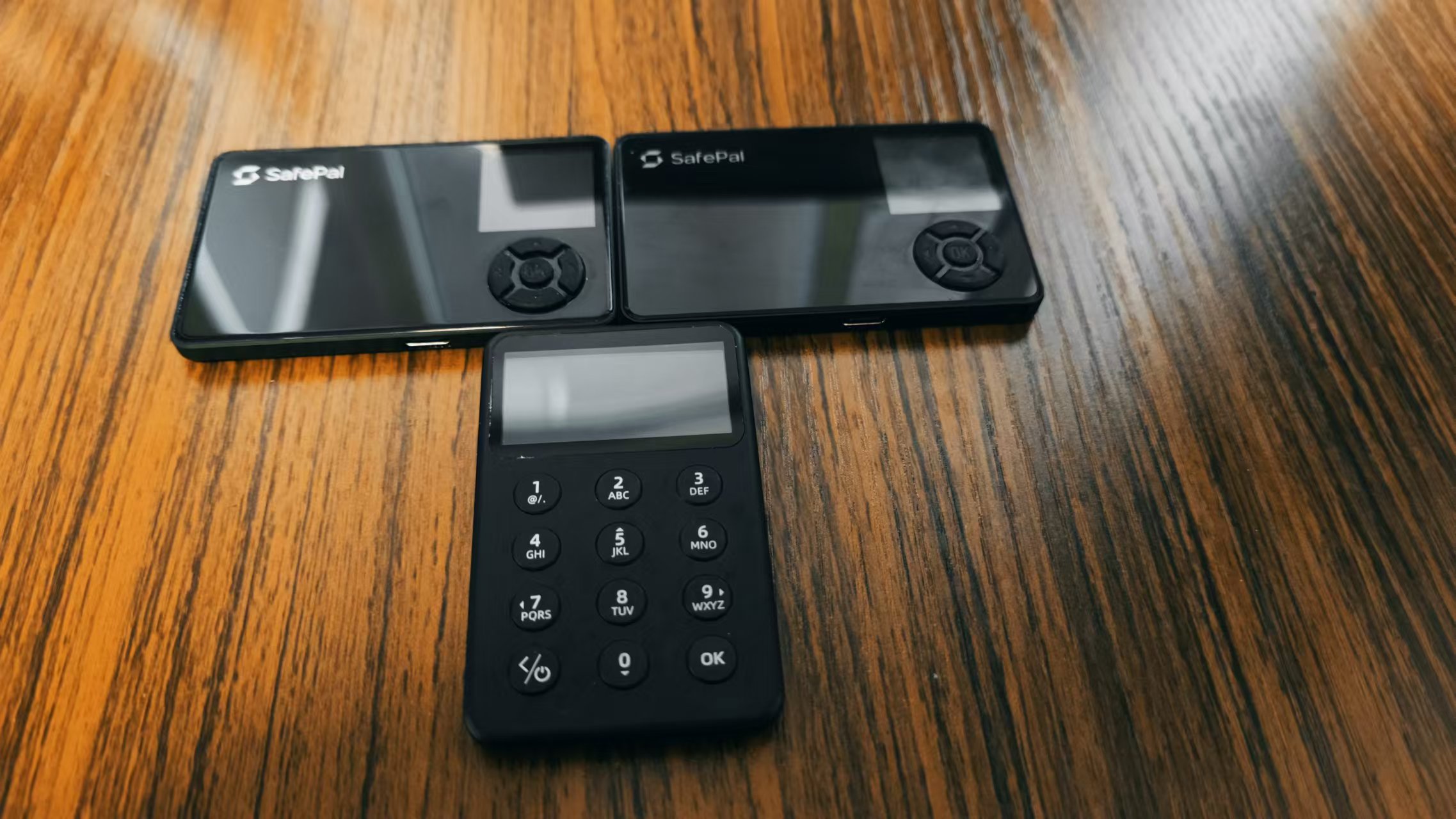
SafePal S1:售价最「亲民」的入门款硬件钱包
作为 SafePal 最早推出的首款硬件钱包,SafePal S1 的最大特点就是「便宜好用」,可以说是目前市面上价格最亲民的入门款硬件钱包产品。
目前 S1 官网售价仅 49.9 美元(本文价格均为官网单款直接售价,未考虑组合套餐或分销渠道优惠,下同),在目前主流在售硬件钱包产品的入门款中,属于性价比最高的一批——作为对比,OneKey Classic 1S 为 99 美元、Trezor Model One 为 49 美元、Ledger Nano S Plus 为约 86 美元。
从外观上看,S1 神似早期的 MP3 播放器,尺寸和国内的一张普通银行卡相当,便于随身携带(可以完美放入存放银行卡的钱包),正反面的配置十分简约:
正面,最右侧分别为上方的彩屏(显示钱包信息与二维码)+下方的方向键(用于菜单导航);
反面,上方最右侧配备一个摄像头,用于在签名交易时扫描二维码;
整机右侧,唯一的按钮为开机按键;整机下方,则有一个 Type C 接口(充电/连接设备);
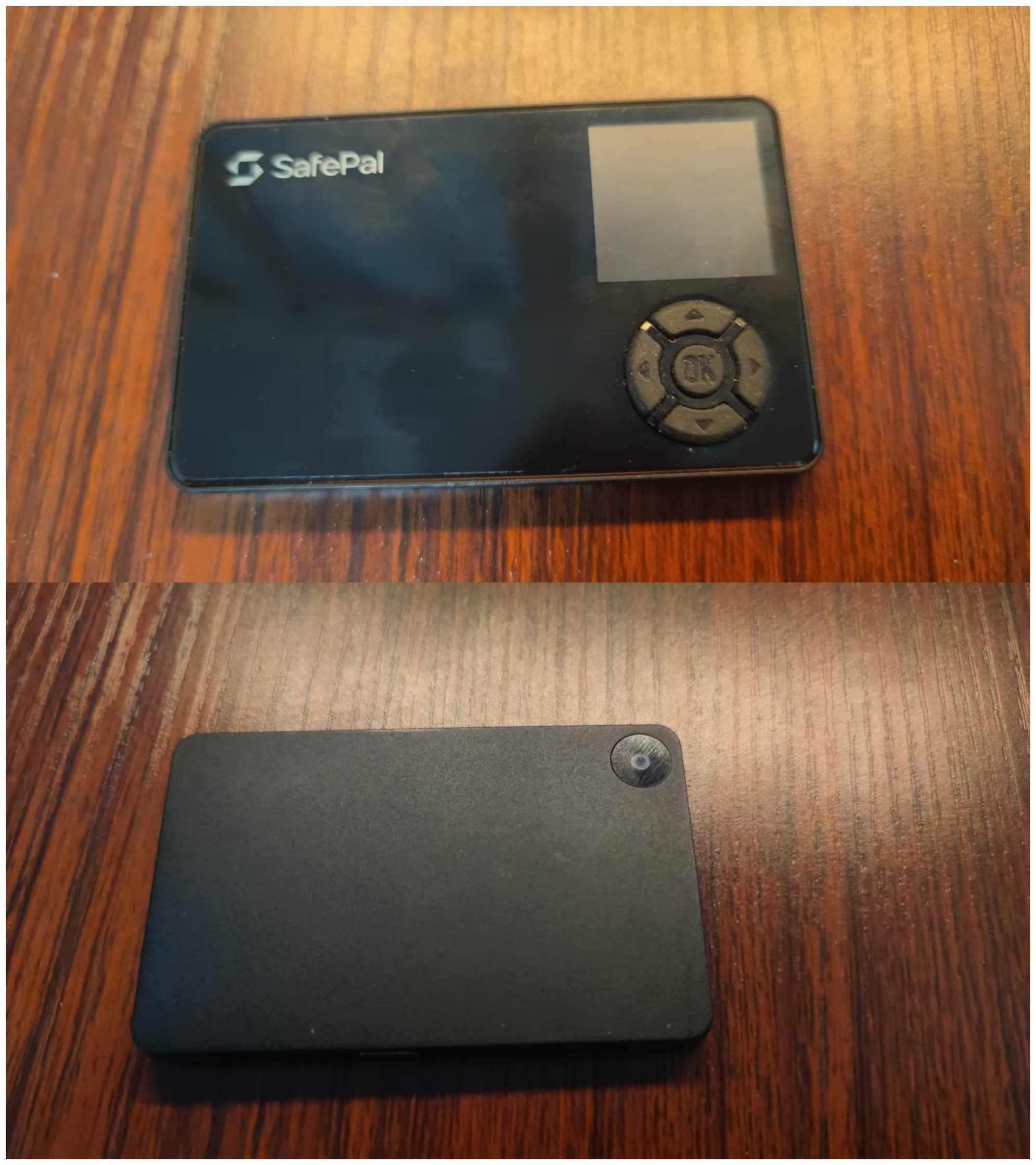
因此 S1 与外界唯一的通信手段就是「屏幕显示」和「摄像头扫码」,除更新固件、充电外,几乎彻底物理隔离,无需进行任何有线连接,极大降低了远程攻击风险,安全系数很高,当然这也意味着操作相对繁琐,尤其是对需要高频操作的用户来说:
理论上,日常的每笔交互,都需要 S1 与手机 APP 端相继互扫通过二维码,完成离线签名,以授权或发送交易。
从实际握持的体验来看,能明显感觉到 S1 手感轻盈,塑料感较强,材质上偏「实用主义」,不软,耐压性好。
与此同时,相比部分硬件钱包的轻薄设计,S1 厚度适中,所以抗弯折能力更强(如下图,从上到下依次为 imToken imKey、OneKey Classic、SafePal S1),个人使用中还未出现过类似 OneKey Classic 不慎弯折损坏的尴尬情况....
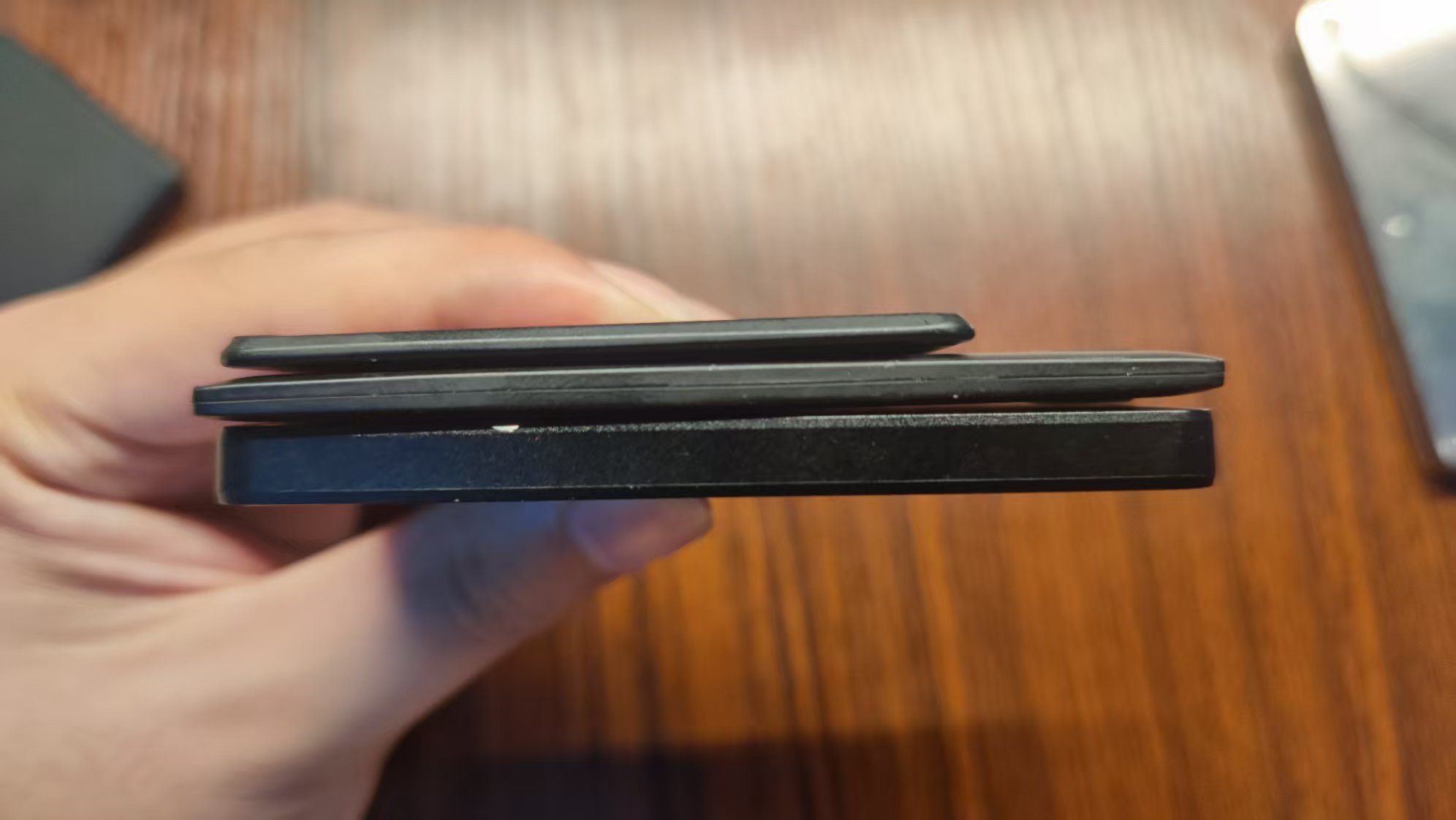
以下为首次激活与使用流程:
1.开机设置,创建/恢复钱包
长按右侧的开机键,待屏幕亮起,进入显示语言选择界面,选择「简体中文」,随后确认按键指引,进入初始化页面,点击「好,开始吧」,即可进入钱包设置页面,有两个选项:
「创建全新钱包」:离线生成并备份一组全新的助记词,可自主选择是 12 位、18 位还是 24 位单词,随后备份验证,即可正常使用;
「恢复已有钱包」:根据此前备份的助记词,输入后恢复旧钱包,即可正常使用;
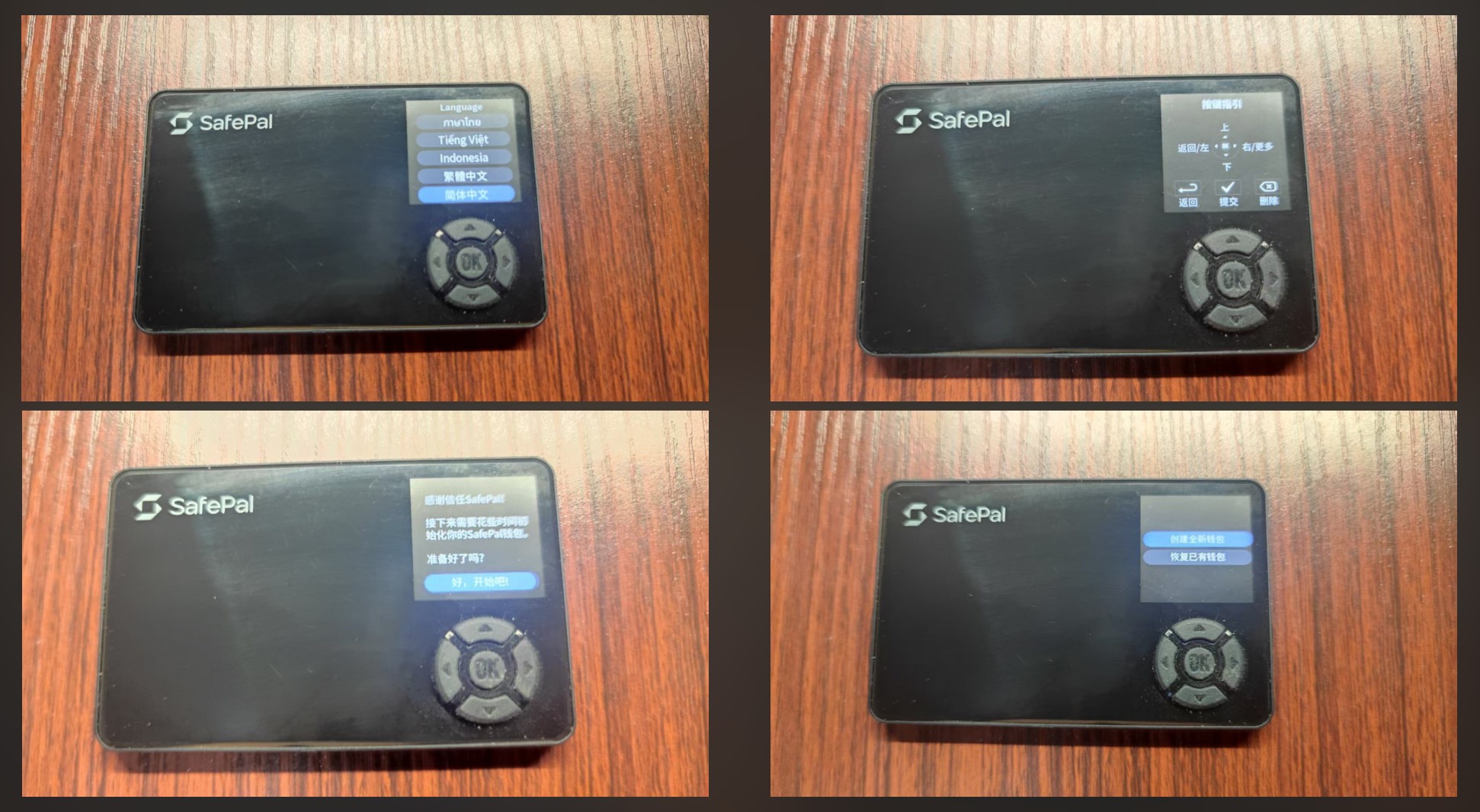
2.设置 PIN 码
钱包创建或恢复后,进入 PIN 码设置页面,可输入 6 位、8 位或其他位数的 PIN 码,然后给该硬件钱包命名,即完成初步设置。
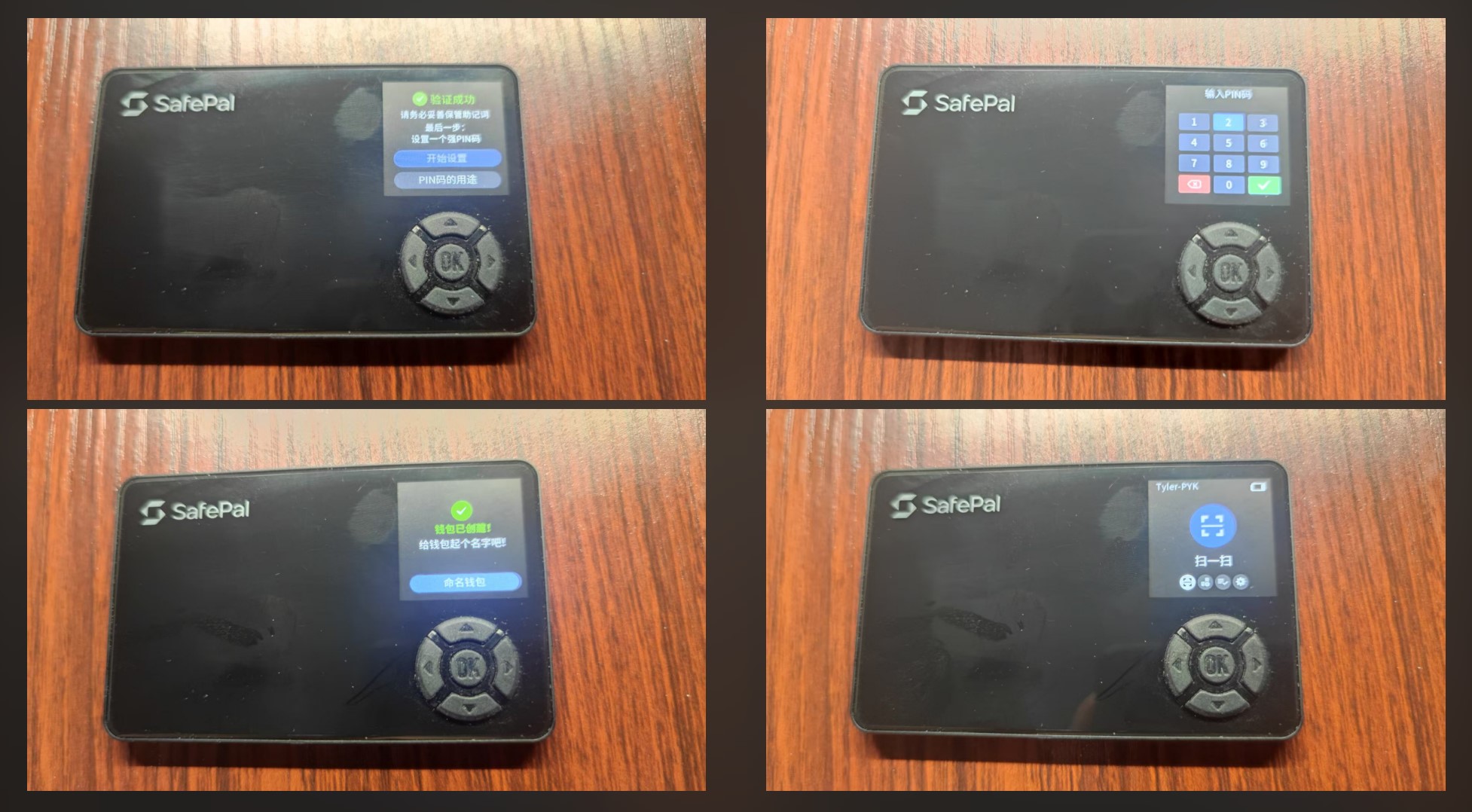
3.手机端 App 配对(扫码绑定)
硬件钱包设置完成后,下载并打开 SafePal 钱包 App,点击 App 首页最上方的钱包名称(如下图的「Tyler-S0K#1」处),进入钱包管理界面。
紧接着在钱包管理界面中,点击 「添加钱包」 按钮,选择「连接硬件钱包」选项,此时会出现 SafePal 不同型号硬件钱包(如 S1、X1、S1 Pro )的选项,选择对应的硬件钱包型号(图中为 S1 )
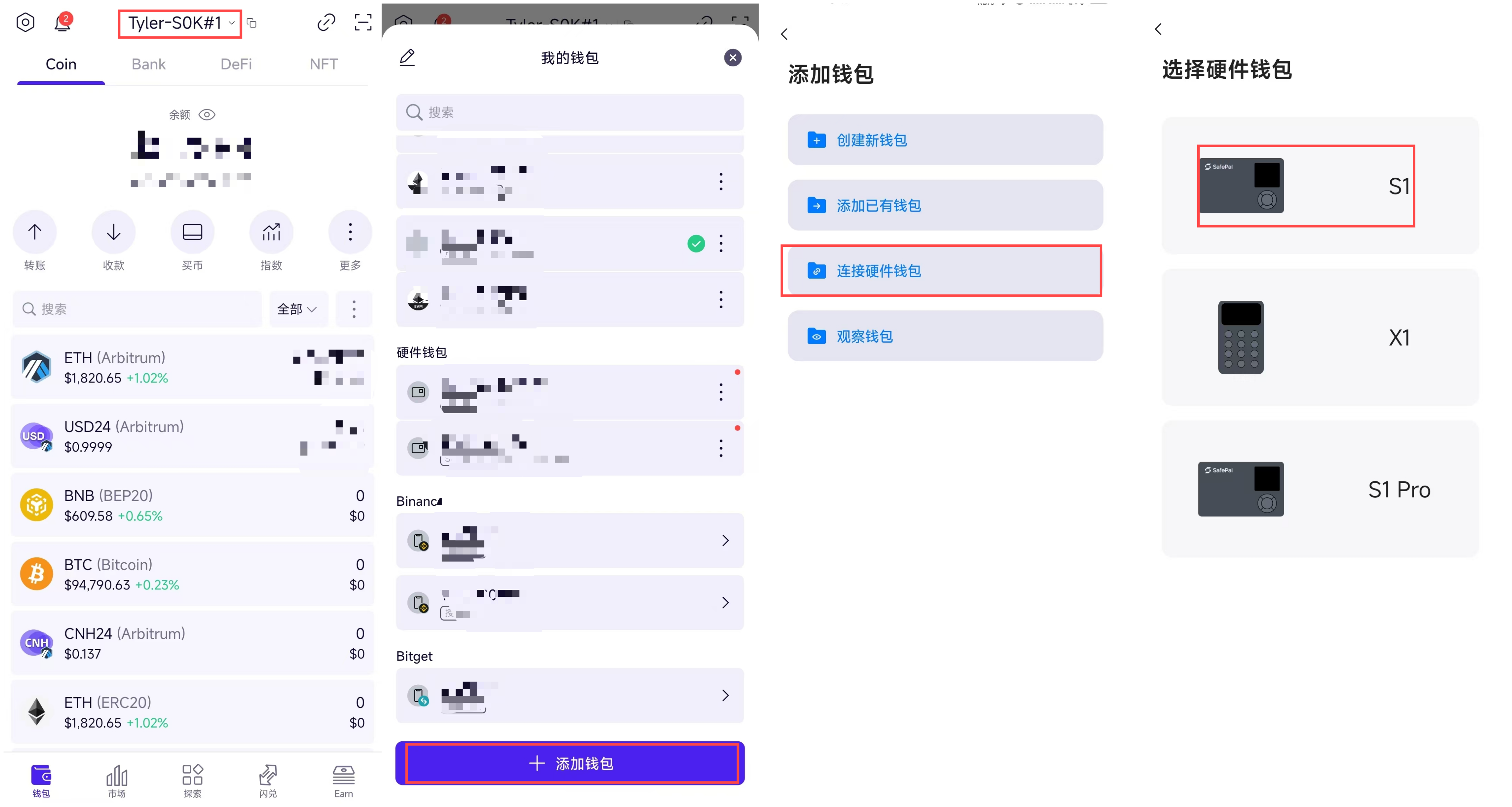
随后根据提示,使用 S1 摄像头扫描手机屏幕上显示的二维码。
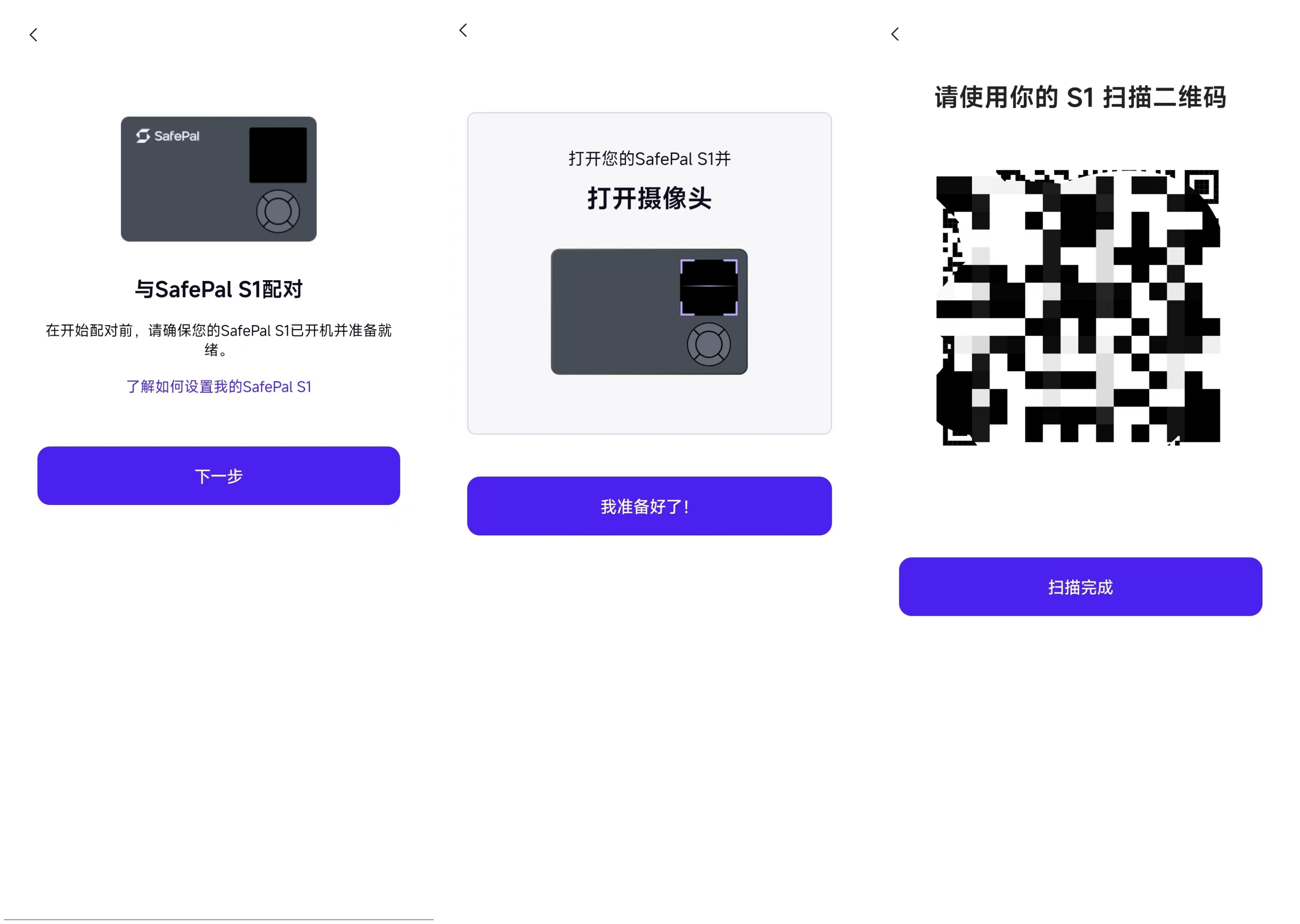
S1 扫码完成后,选择「确定」绑定此钱包,就会出现 13 张不断交替出现、含有私钥签名信息的二维码图片。
此时再回到 App 端,使用扫码功能扫描显示在 S1 上的二维码,保持一段时间,直到 13 张全部扫描结束,即可完成硬件钱包与手机 App 的绑定配对。
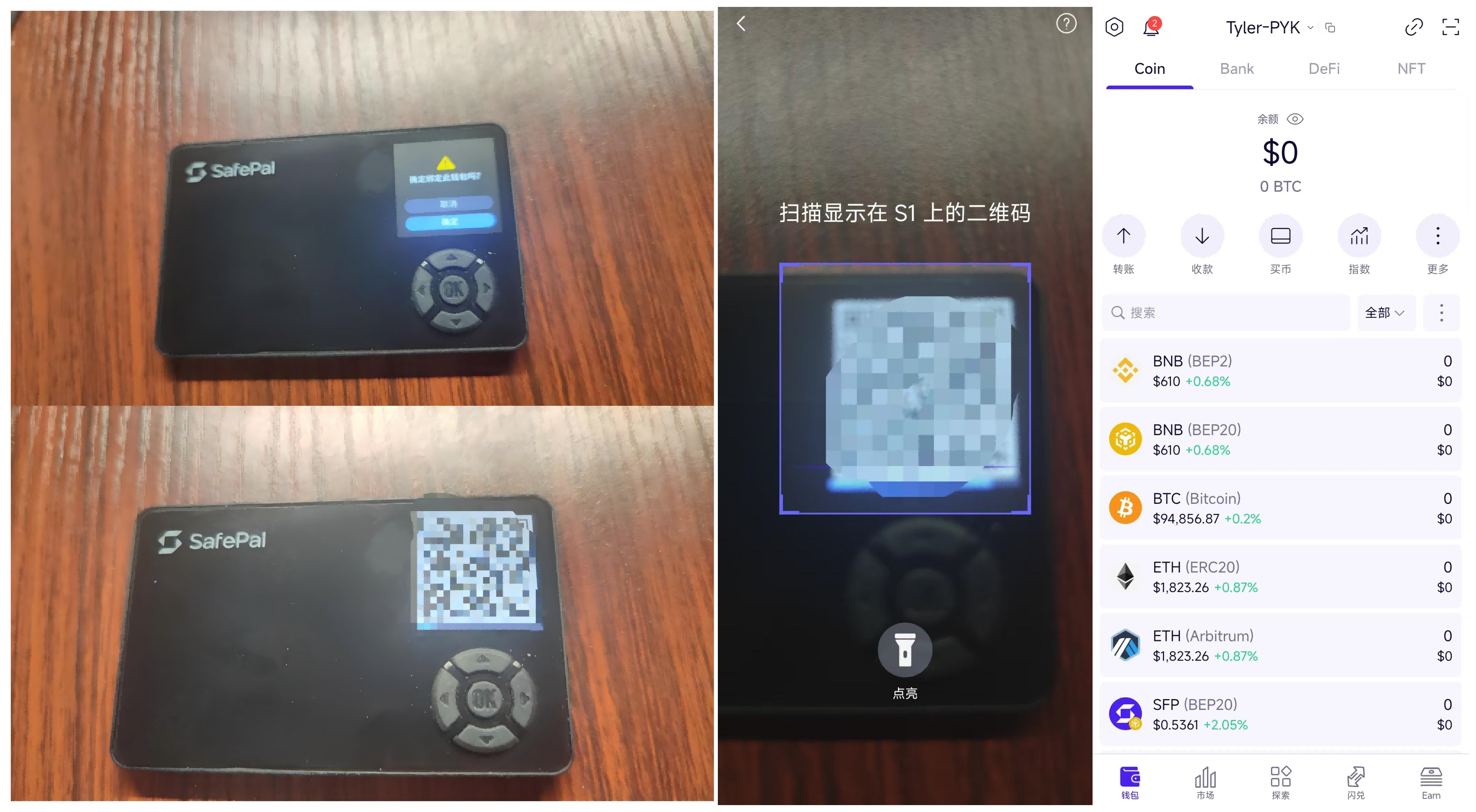
绑定完成后,SafePal App 即可同步 X1 钱包内的地址与资产信息,用户可在 App 中直接查看各条链资产余额,如 BTC、ETH、BNB 等,以及进行后续的转账、授权等链上交互。
4.日常交易的签名/授权
配对成功后,返回 App 首页,即可通过手机端 App 对已连接的硬件钱包进行转账、收款等各类链上交互操作时,涉及授权/签名等环节需在 S1 上进行确认——通过二维码传递信息,完成离线签名。
在此以日常的转账操作为例:
发起转账操作:在转账界面选择付款钱包(已连接的硬件钱包对应的账户),填写好转账币种(如 BNB)、收款地址、转账金额后,点击「下一步」;
确认交易详情:弹出转账确认界面,显示付款地址、收款地址、转账金额、矿工费等详细信息,再次核对信息,确认无误后点击 「转出」;
触发生物识别校验:系统弹出指纹验证弹窗(若设置了指纹支付),验证指纹,否则为 App 端的 PIN 码输入;
生成交易二维码:验证通过后,App 会生成一张包含完整交易信息的二维码(如图最后一张),同时展示校验码供用户二次核对。此二维码即为需要由硬件钱包扫码读取、进行离线签名的交易数据;
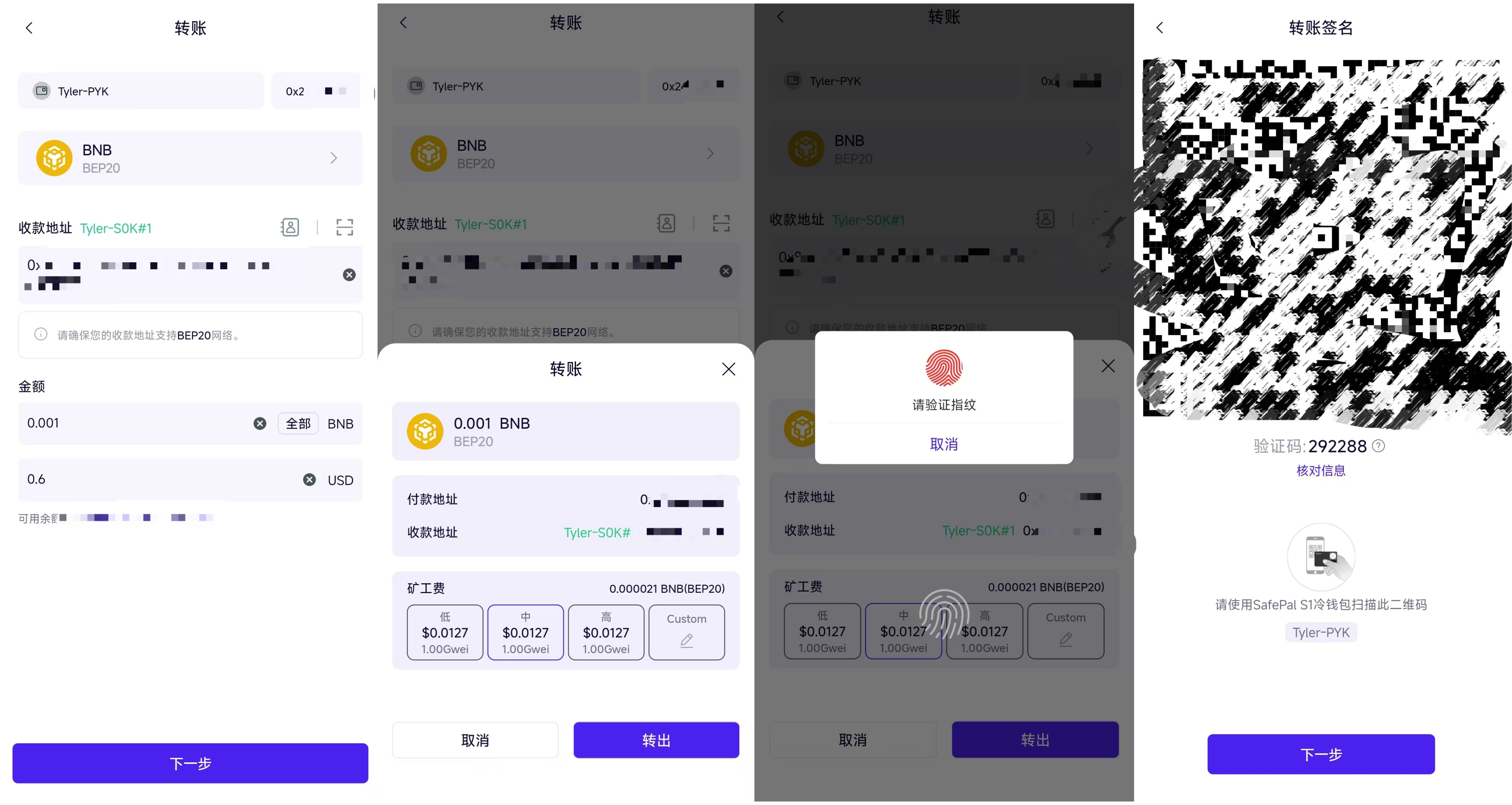
此时使用 S1 硬件钱包,扫描手机上显示的二维码,硬件钱包屏幕上会生成一个核验页面,核对交易关键信息(转账金额、地址、矿工费等)无误后,点击「OK」并输入个人此前设置的 PIN 码,随后便在 S1 屏幕上生成 2 张不断交替出现、含有私钥签名信息的签名二维码。
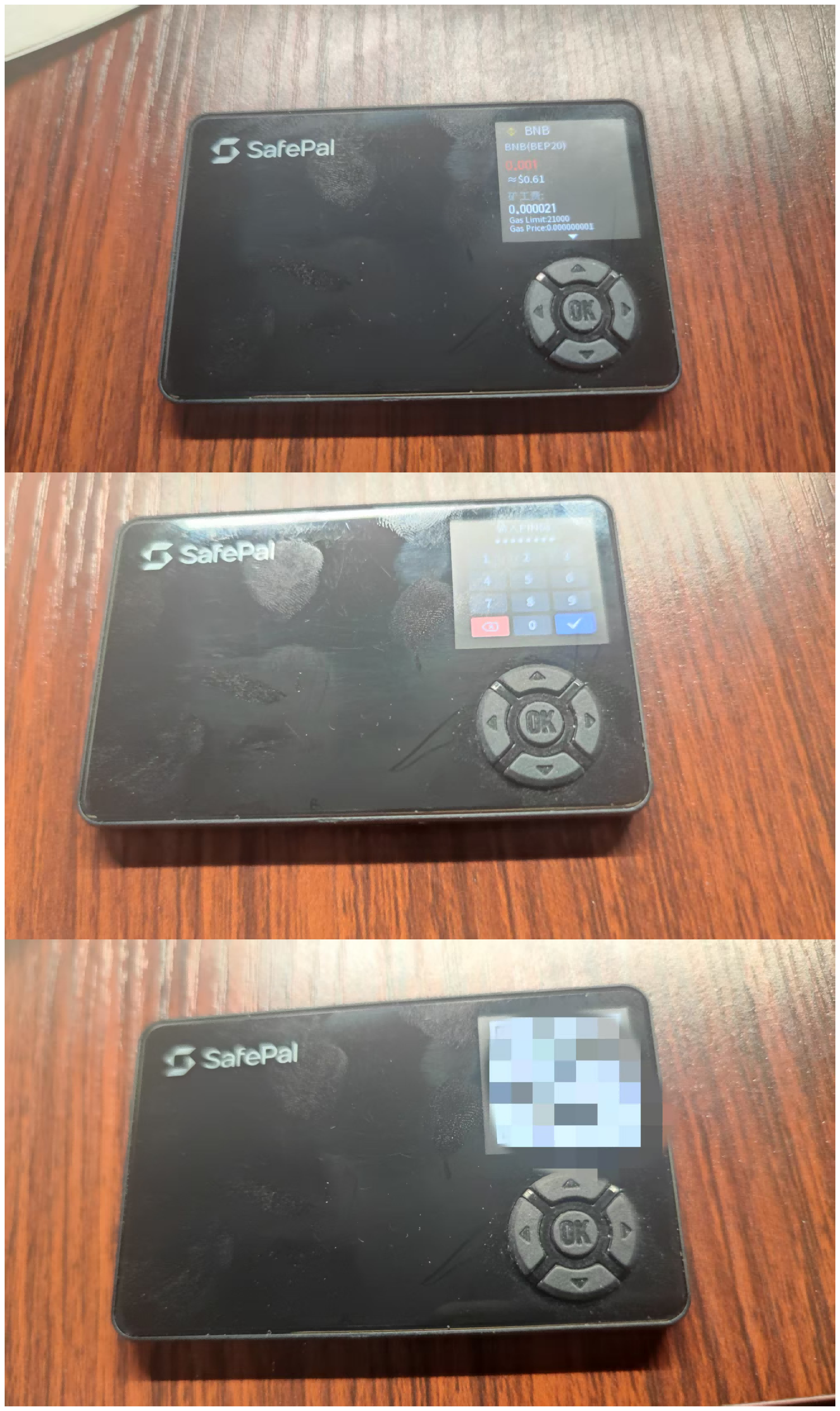
最后回到 App 端,将 S1 屏幕上的二维码出示给手机 App 扫码,即可进行签名,广播到链上完成交易。
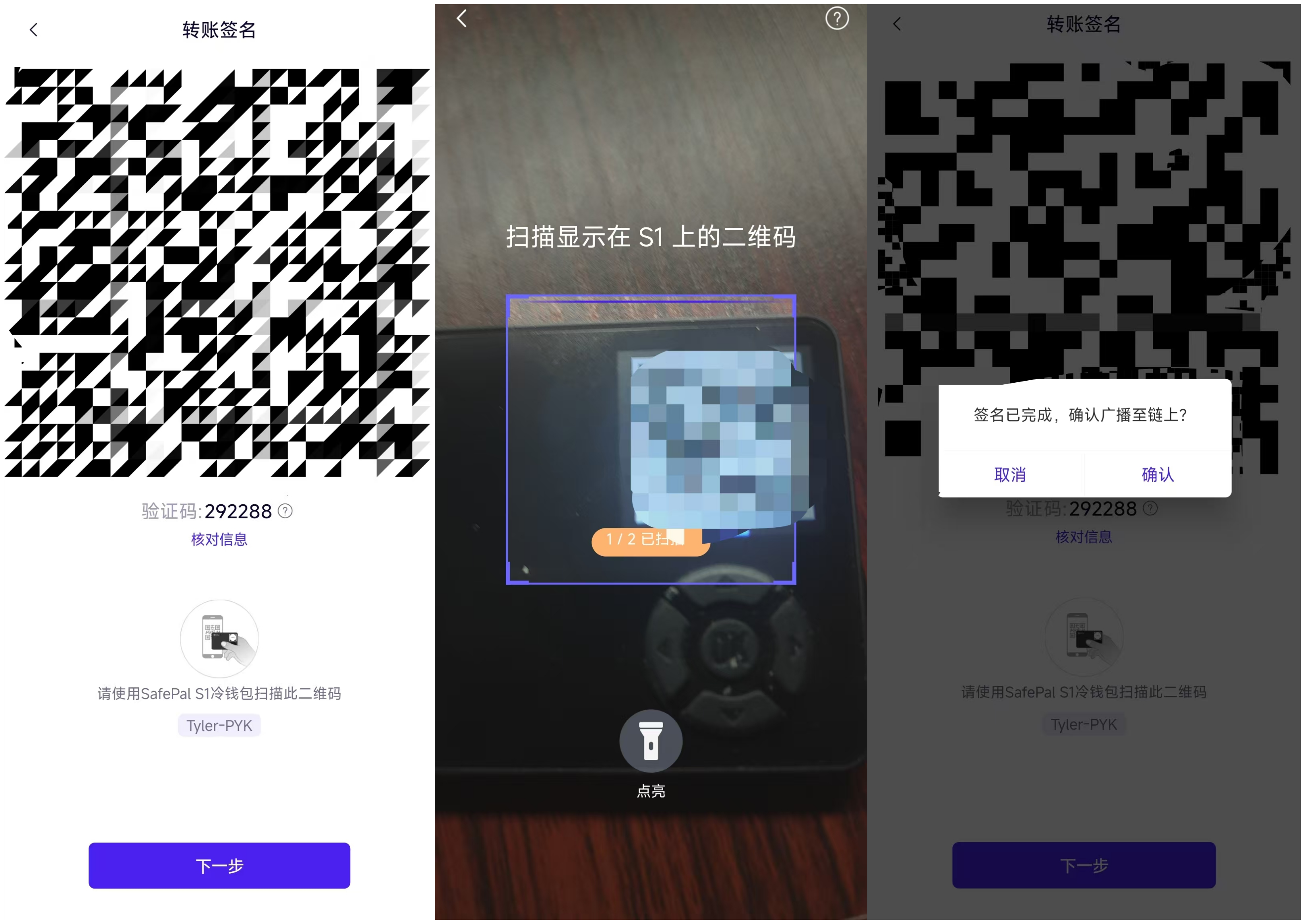
从以上的 S1 +钱包 App 的操作流程就可以发现,日常交易过程中,用户可将 SafePal 硬件钱包与 App 配对,二者通过二维码传递信息,期间 S1 完全不触网,整体体验强调的是「极致隔离、极致安全」,适合长期「屯币」,或不需要频繁链上交互的使用场景。
一句话总结,S1 凭借二维码设计实现了极致安全隔离,很适合初次接触冷钱包、希望以低成本「安全屯币」的用户——仅需不到 50 美元,就能安全买买屯上百条主流公链的 Crypto 资产,当然二维码隔离设计也导致它的签名流程相对繁琐,并不适合日常交互的高频用户需求。
SafePal S1 Pro:S1 全面升级版本
作为 SafePal S1 的迭代升级款(价格从 49.9 美元提升至 89.99 美元),S1 Pro 在外观尺寸上虽与 S1 基本一致,但在细节打磨和使用体验上,明显更胜一筹。
首先是材质的全面升级,从 S1 的 ABS + PVC 升级为铝合金+钢化玻璃,电池容量也从 400 mAh 扩充至 500 mAh,机身整体更为轻薄紧凑,四角改为圆润收边设计,提升了握持舒适度。
表面材质去除了 S1 上较为明显的「塑料感」,整体更有一种偏向陶瓷质地的细腻感与紧实感,整体轮廓更贴手,使得 S1 Pro 在手感上更偏向「润」而非「糙」,在不牺牲硬度和抗压性的前提下,外壳质感实现了可感知的跃升。
其次是摄像头位置的结构性优化——S1 Pro 将背部摄像头从 S1 的右上角改为居中布局,不仅孔径更小、观感更协调,也解决了 S1 在扫码签名时因屏幕与摄像头位置割裂,导致扫码需频繁调整角度的问题,显著提升了二维码的识别效率。
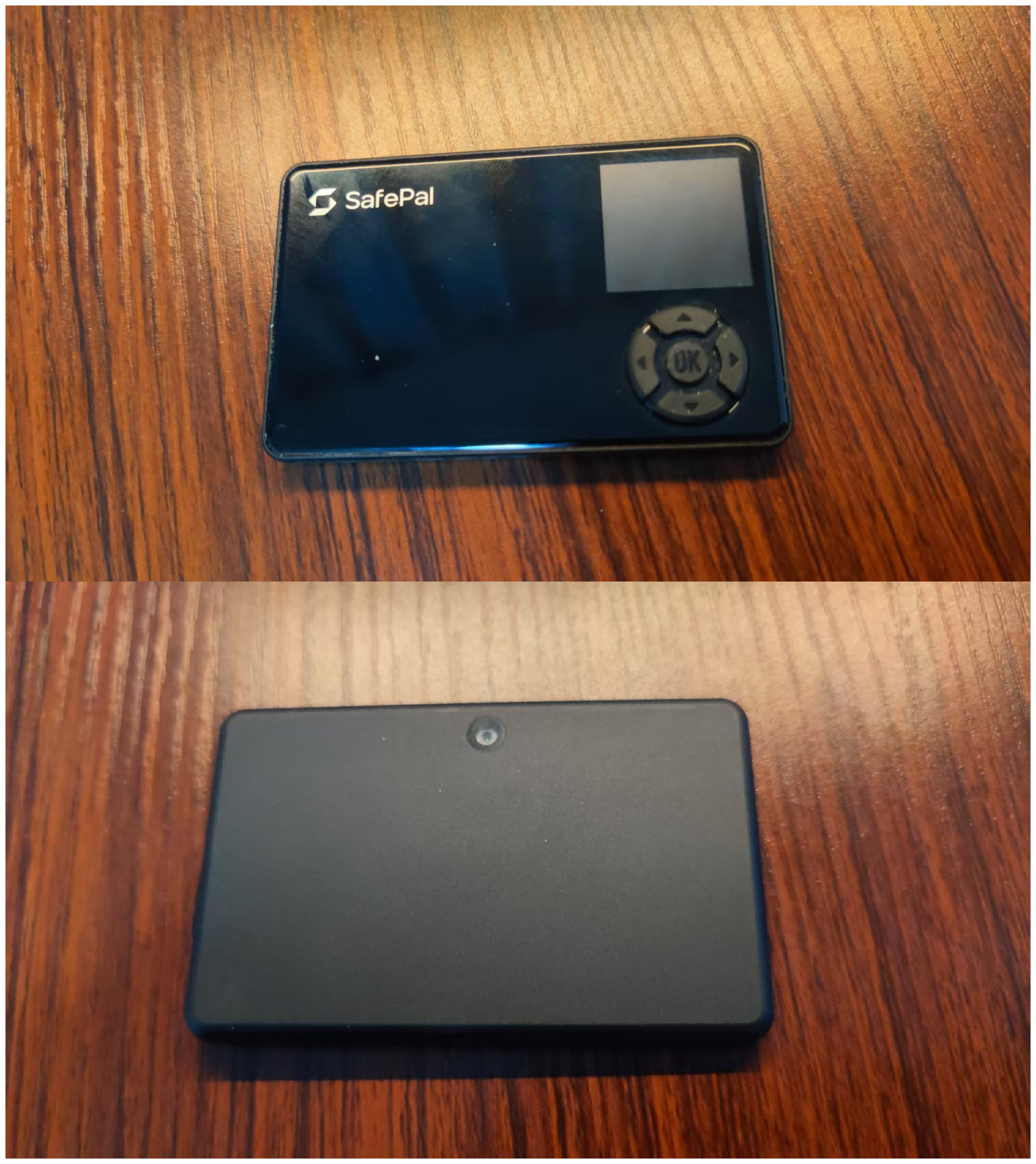
至于 S1 Pro 的首次激活与使用流程与 S1 一致,在此就不过多赘述。
当然,和 S1 一样,S1 Pro 延续了二维码签名带来的「高安全、操作略繁琐」特点,因此在应用场景上与 S1 相似,更适合注重资产安全存储、屯币需求的用户,对于高频交易用户而言,其操作流程仍存在一定局限性。
SafePal X1:蓝牙款,「跨设备/多账户」设备切换利器
SafePal X1 是 SafePal 推出的首款蓝牙硬件钱包(69.9 美元),尺寸略窄于普通的银行卡,较为小巧,与 S1 与 S1 Pro 相比,屏幕尺寸从 1.3 寸升级为 1.8 寸,同时配备 12 键实体按键(10 位数字键盘+2 个功能键),输入 PIN 码、切换不同页面等操作时更为直观便捷。
与 S1 和 S1 Pro 的二维码离线交互模式不同,由于 X1 是通过蓝牙连接,所以用户可以在多个设备间快速切换,实现高效的资产管理和交易签名,适合多账户、多设备频繁进行加密资产操作的用户:
用户可以在手机上管理日常交易,在平板上进行资产分析,在电脑上进行大额转账,所有操作都可通过 X1 快速完成签名,无需反复插拔设备或扫描二维码,提升了操作效率。
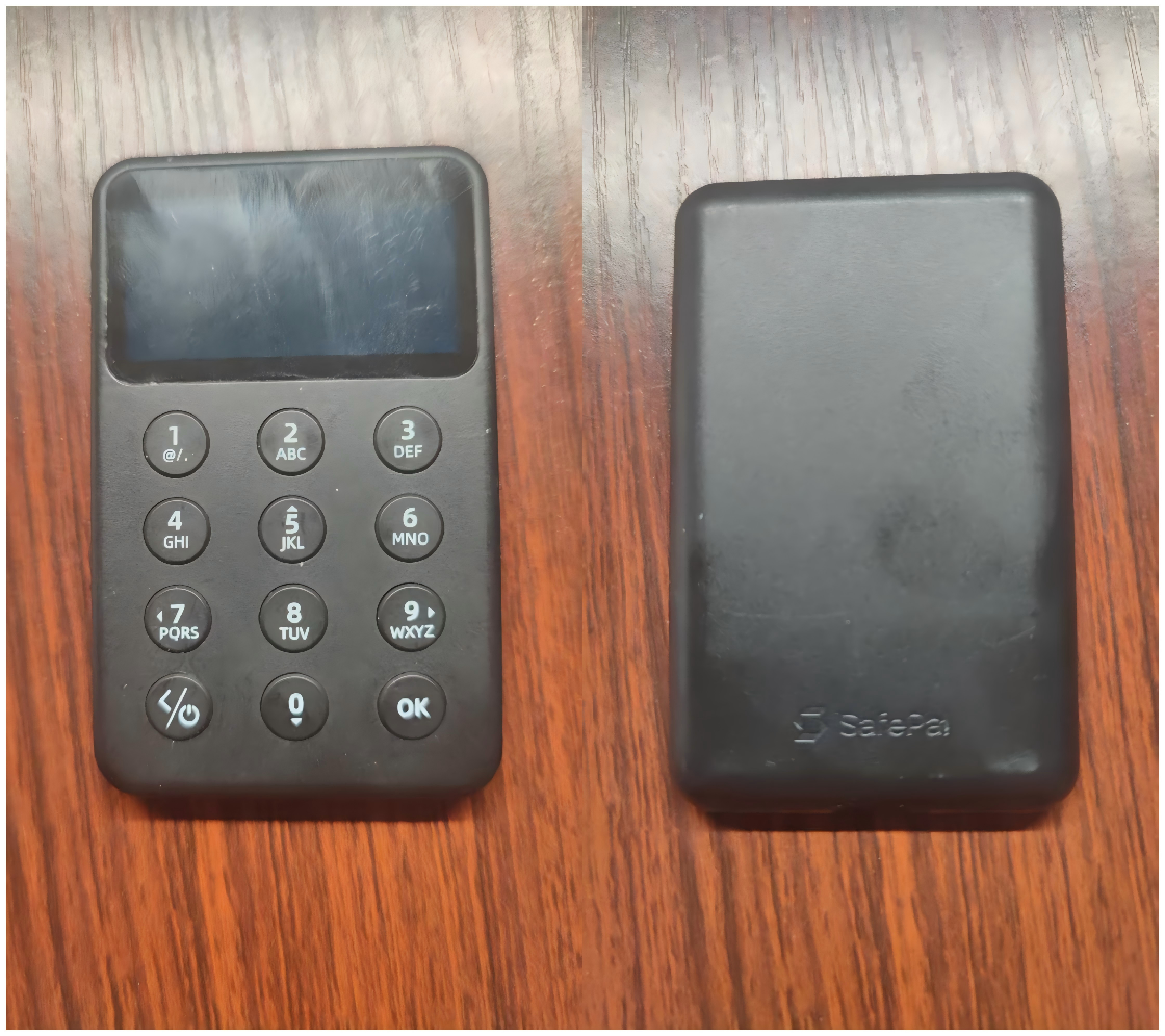
以下为首次激活与使用流程:
1.开机设置,创建/恢复钱包
长按正面左下角的 X1 电源键开机,待屏幕亮起,进入显示语言选择界面,使用数字键选择「简体中文」,按「OK」确认。
和 S1、S1 Pro 一样,进入钱包设置页面,有两个选项:
「创建全新钱包」:离线生成并备份一组全新的助记词,可自主选择是 12 位、18 位还是 24 位单词,随后备份验证,即可正常使用;
「恢复已有钱包」:根据此前备份的助记词,输入后恢复旧钱包,即可正常使用;
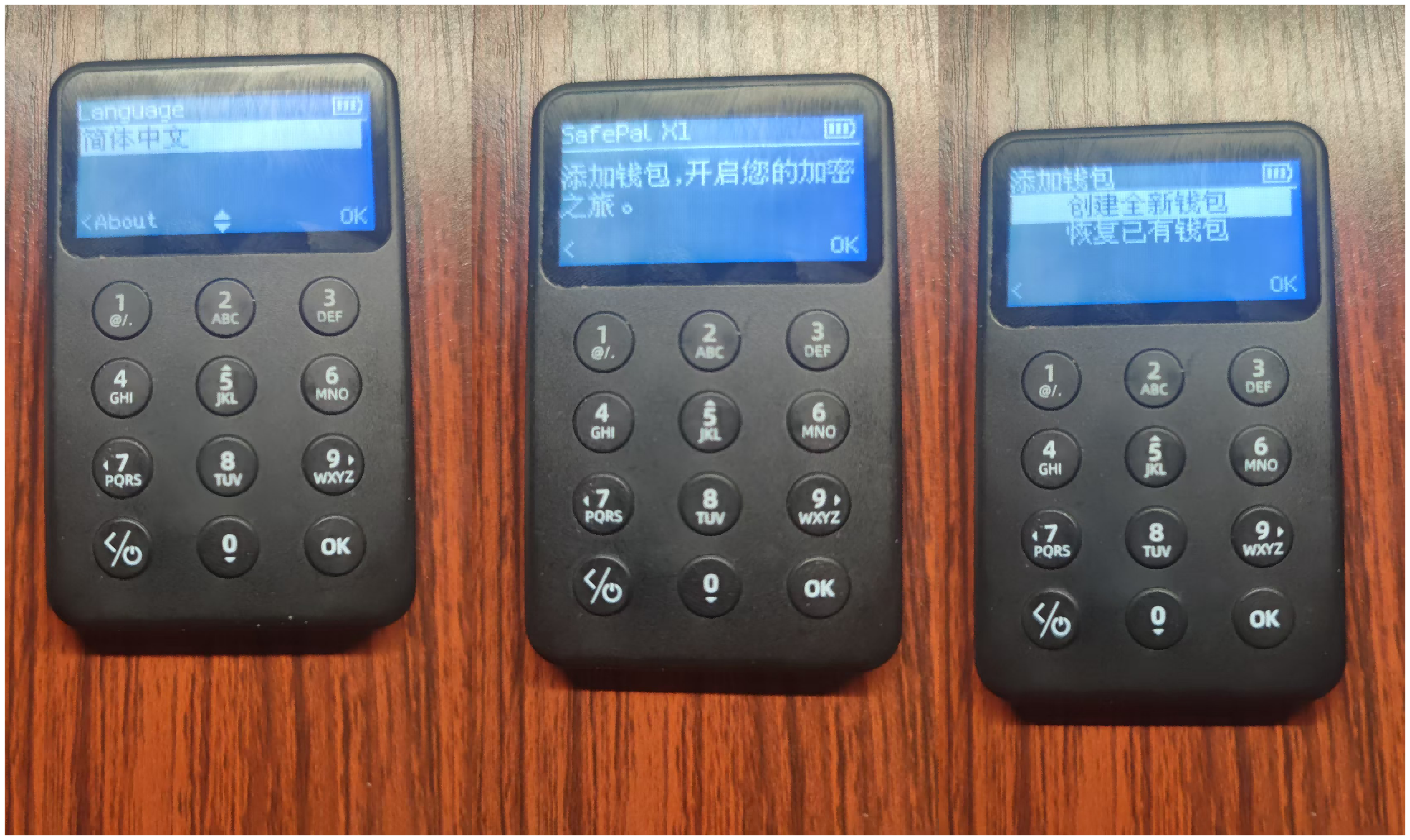
2.设置 PIN 码
钱包创建或恢复后,进入 PIN 码设置页面,可输入 6 位、8 位或其他位数的 PIN 码,然后给该硬件钱包命名,即完成初步设置。
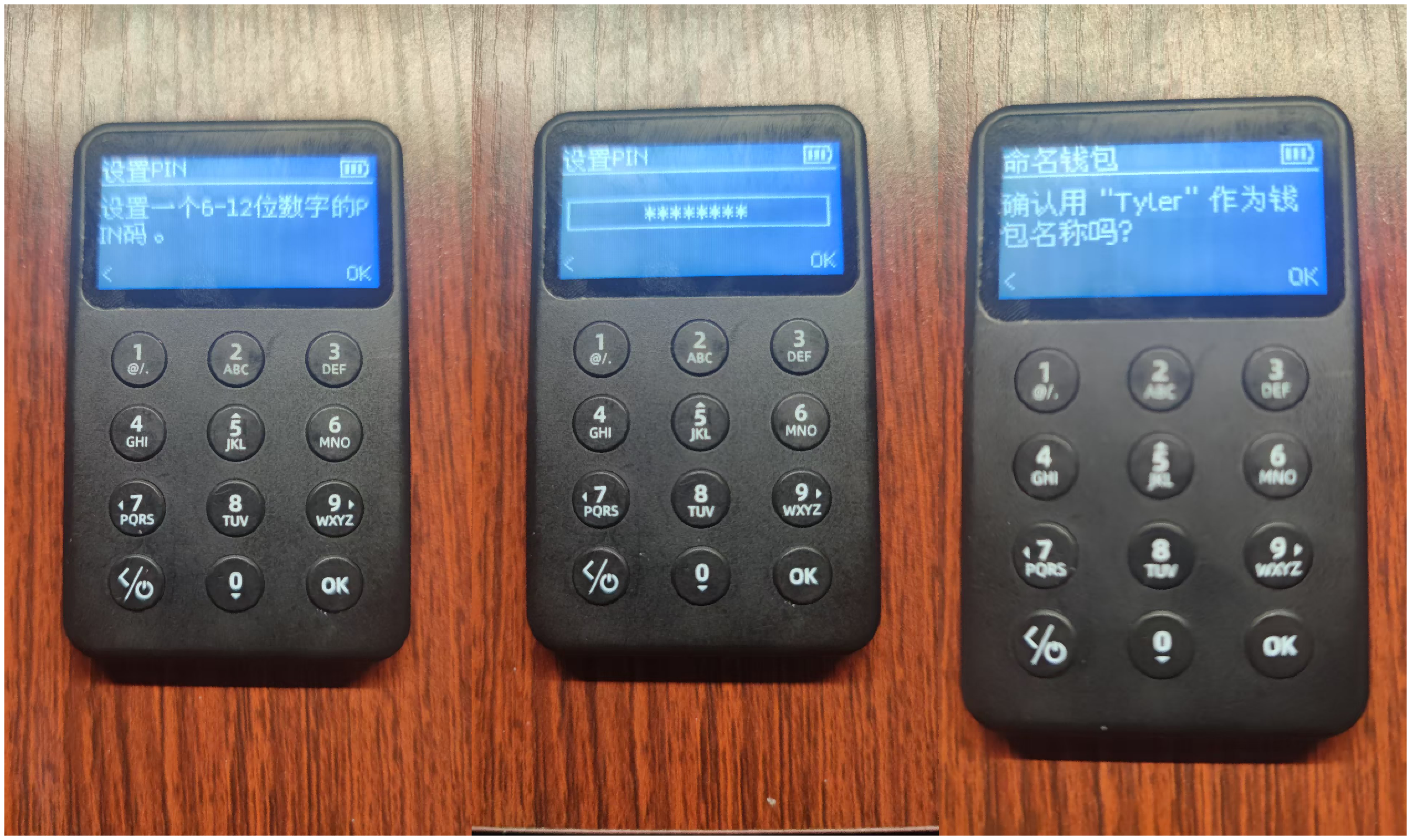
3.手机端 App 配对(蓝牙绑定)
硬件钱包设置完成后,下载并打开 SafePal 钱包 App,点击 App 首页最上方的钱包名称(如下图的「Tyler-S0K#1」处),进入钱包管理界面。
紧接着在钱包管理界面中,点击 「添加钱包」 按钮,选择「连接硬件钱包」选项,此时会出现 SafePal 不同型号硬件钱包(如 S1、X1、S1 Pro )的选项,选择对应的硬件钱包型号(图中为 X1 )。
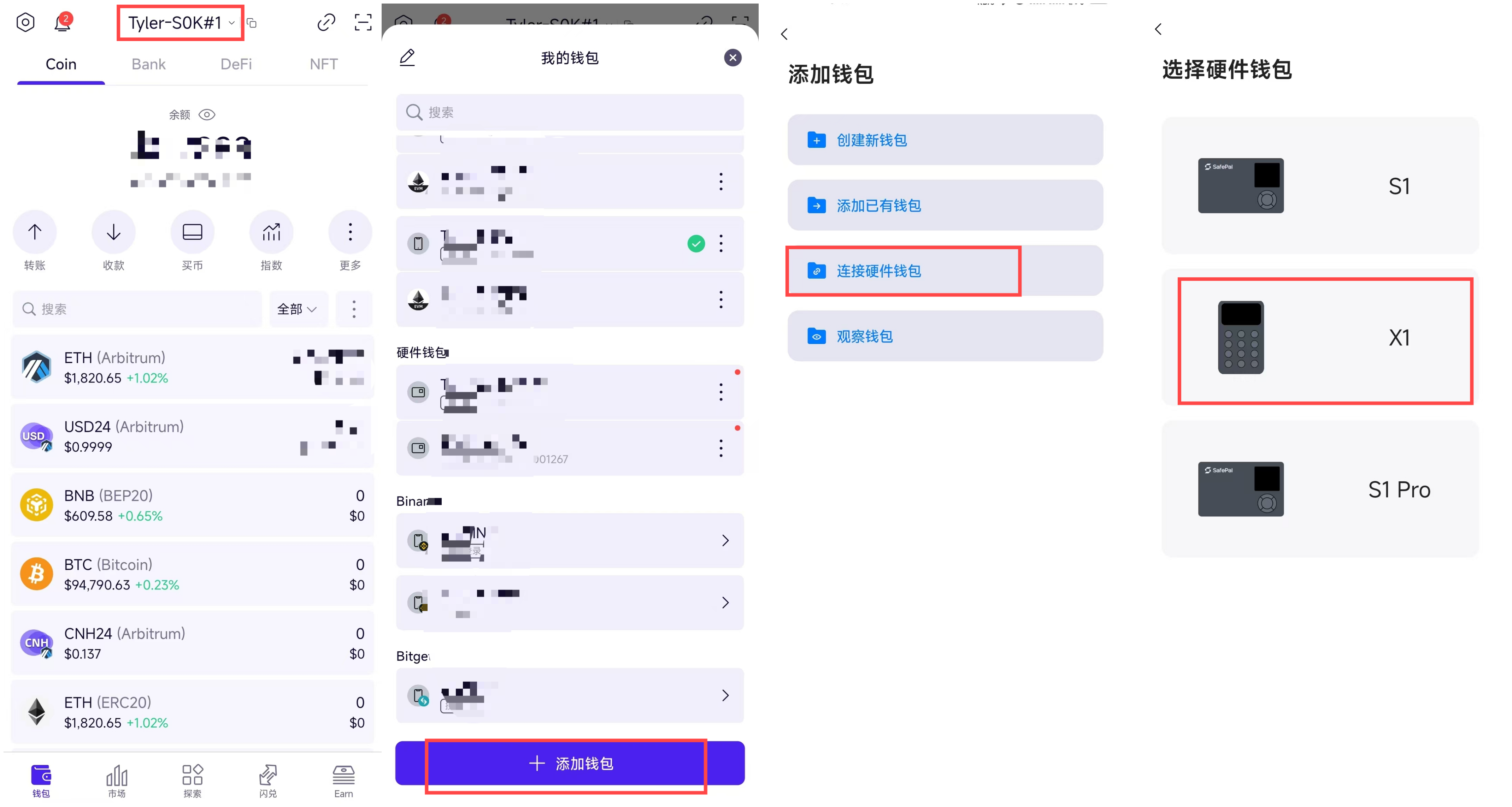
在确保打开手机蓝牙的情况下,App 将自动开始搜索周边蓝牙设备,当 X1 处于开机状态且蓝牙功能也打开时,便会自动搜索匹配到该 X1 硬件钱包——如图所示,设备名如「SafePal X1-830B」将出现在钱包 App 中的可用设备栏。
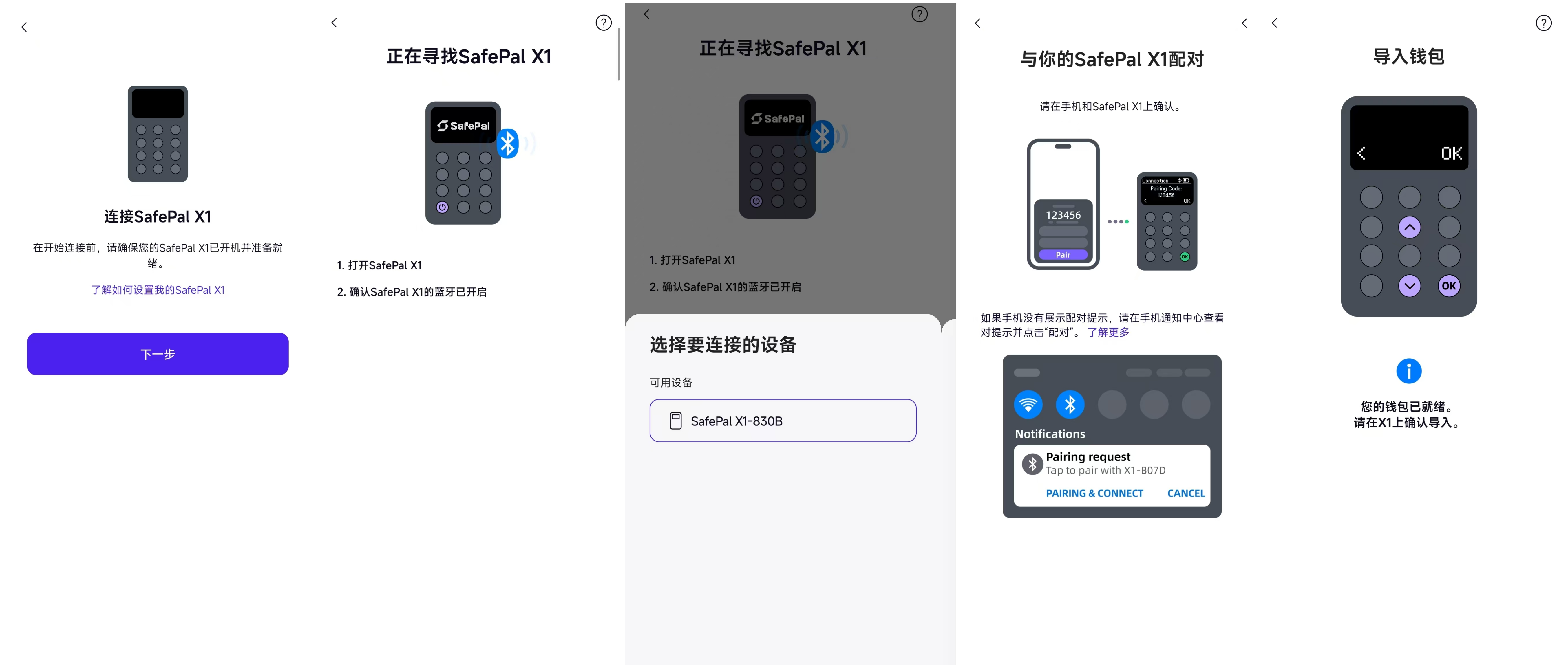
点击对应设备名称后,App 会自动发起配对请求,同时在 X1 屏幕上输入 PIN 码,确认配对绑定,用户只需使用实体按键中的「OK」键完成确认,即完成钱包在硬件设备上的绑定流程。
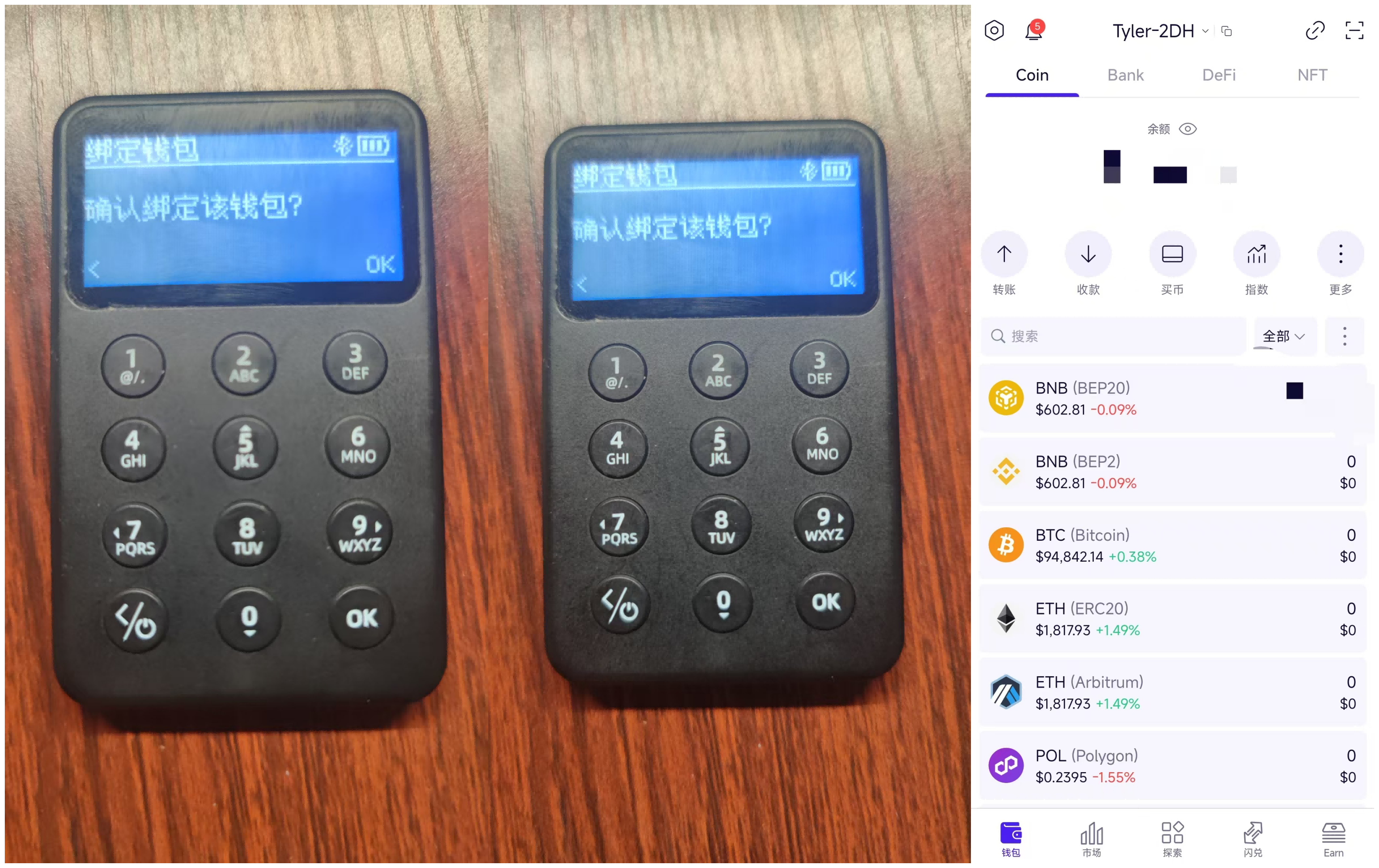
绑定完成后,SafePal App 即可同步 X1 钱包内的地址与资产信息,用户可在 App 中直接查看各条链资产余额,如 BTC、ETH、BNB 等,以及进行后续的转账、授权等链上交互。
4.日常交易的签名/授权
配对成功后,用户即可通过 SafePal App 对已连接的 X1 蓝牙硬件钱包进行转账、授权等各类链上操作,整个过程中无需扫码,全部交互数据将通过蓝牙自动加密传输,并在 X1 屏幕上进行确认与签名。
以下以日常转账操作为例,展示完整的蓝牙签名流程:
发起转账操作:在 SafePal App 中选择付款钱包(即绑定 X1 的账户),填写币种(如 BNB)、收款地址、金额,点击「下一步」;
确认交易详情:App 会弹出交易确认界面,显示付款地址、收款地址、转账金额与矿工费等详细信息,仔细核对无误后点击「转出」继续操作;
触发生物识别校验:若启用了指纹支付功能,系统将弹出指纹识别框,若未启用则需输入 SafePal App 的 PIN 码;
蓝牙推送签名请求:身份验证通过后,交易数据将通过蓝牙推送至 X1 硬件钱包m此时,X1 屏幕将自动弹出交易确认界面,展示核心信息(转账金额、地址、Gas 费等),确保用户再次核对无误;
用户确认信息无误后,使用 X1 实体按键完成 PIN 码输入,并点击「OK」进行交易签名,签名完成后,X1 会自动通过蓝牙将签名数据回传至 App,App 自动发起交易广播,交易进入链上确认流程。
该笔交易完成后,等待区块链网络确认交易,可在 App 上查看交易状态和进度。

总的来看,SafePal X1 蓝牙款硬件钱包为用户提供了一种无需频繁扫码、无需插线传输,即可完成高频操作的「秒级响应体验」——交易请求通过蓝牙加密推送,用户仅需在 X1 实体设备上完成 PIN 输入与按键确认,即可完成离线签名,全程私钥不触网。
尤其是通过蓝牙替代二维码的方式,X1 不仅简化了整个签名流程,还有效提升了使用流畅度,特别适合频繁交易、跨设备切换的 Degen 用户,相较于 S1、S1 Pro 最大的优势在于其对「高频、多端、多账户」操作的原生适配:
跨设备操作无缝衔接:X1 可在手机、平板、笔电等多个终端间灵活切换,用户可在手机上管理日常交易,在 PC 上进行 DEX 操作或大额资金调配,蓝牙一键授权,无需反复插拔或扫码,极大提升效率;
多账户并行管理:SafePal App 支持添加多个钱包账户,X1 能通过蓝牙与不同账户间快速配对,无需重复导入助记词,也无需重新初始化设备,通过蓝牙连接快速切换账户,进行相应的资产管理和交易签名,适配进阶用户在多链、多钱包资产管理场景下的高效需求;
这使得 X1 成为当前同类产品中少见的、真正适合「多账户 + 多设备 + 高频交互」的冷钱包解决方案。
在安全硬件标准方面,SafePal X1 正在陆续完成从原先的 CC EAL5+ 向 CC EAL6+ 安全芯片 的更新,达到了与 S1 / S1 Pro 同级别的高安全标准,这种级别的安全认证常用于军事、金融等对数据保护要求极高的场景,确保私钥始终安全存储于独立芯片内,不可被导出或破解。
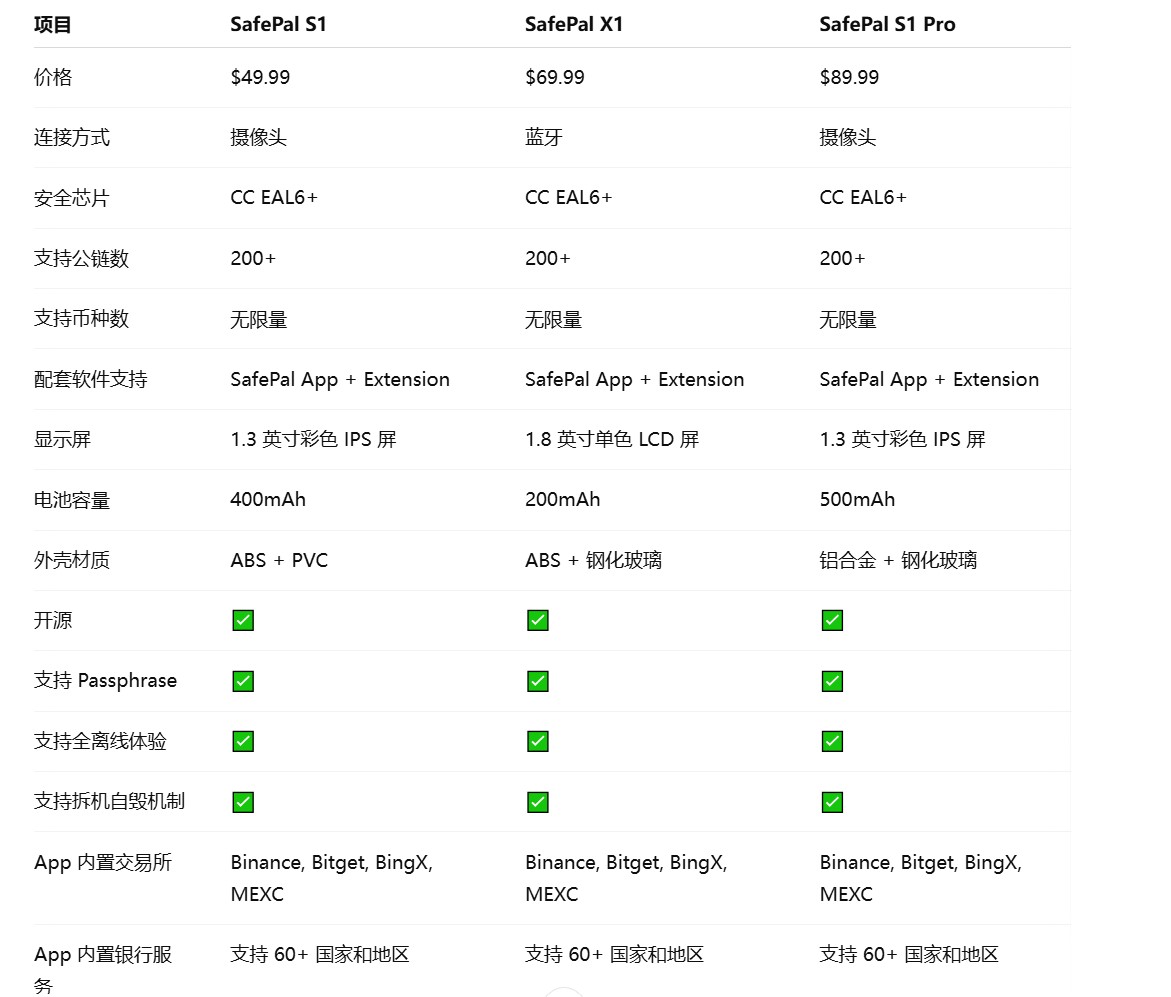
其它配件
为了进一步提升资产备份的安全性与使用便利性,SafePal 还推出了两款实用配件:SafePal Cypher 金属助记词板与硬件钱包专用保护皮套,官网售价分别为 44.99 美元 与 9.9 美元。
其中 SafePal Cypher 是一款专为长期安全备份助记词而设计的不锈钢金属板,遵循 BIP39 助记词标准,支持存储 12、18 或 24 个助记词单词,最大的优势便在于抗火、防水、防腐蚀,更利于长期存储。
毕竟相较于纸质备份易受潮、焚毁、遗失等风险,Cypher 采用工业级不锈钢材料打造,熔点高达 1398°C,远高于普通房屋火灾的平均温度(约 900°C)(市面上同类铝合金制产品熔点约 650°C,在极端情况下存在失效风险)。
同时它具备良好的防潮、防锈、防酸碱能力,即便在恶劣环境中也能长期存储不变形、不损坏,而且抗冲击耐磨损,高强度钢材确保在跌落、撞击等物理损伤场景中依然稳固可靠,此外整体尺寸略大于 S1/S1 Pro,便于携带与保存。
简言之,SafePal Cypher 是一款真正意义上为「几十年备份打算」的冷备解决方案,特别适合注重长期安全的重仓持币用户。
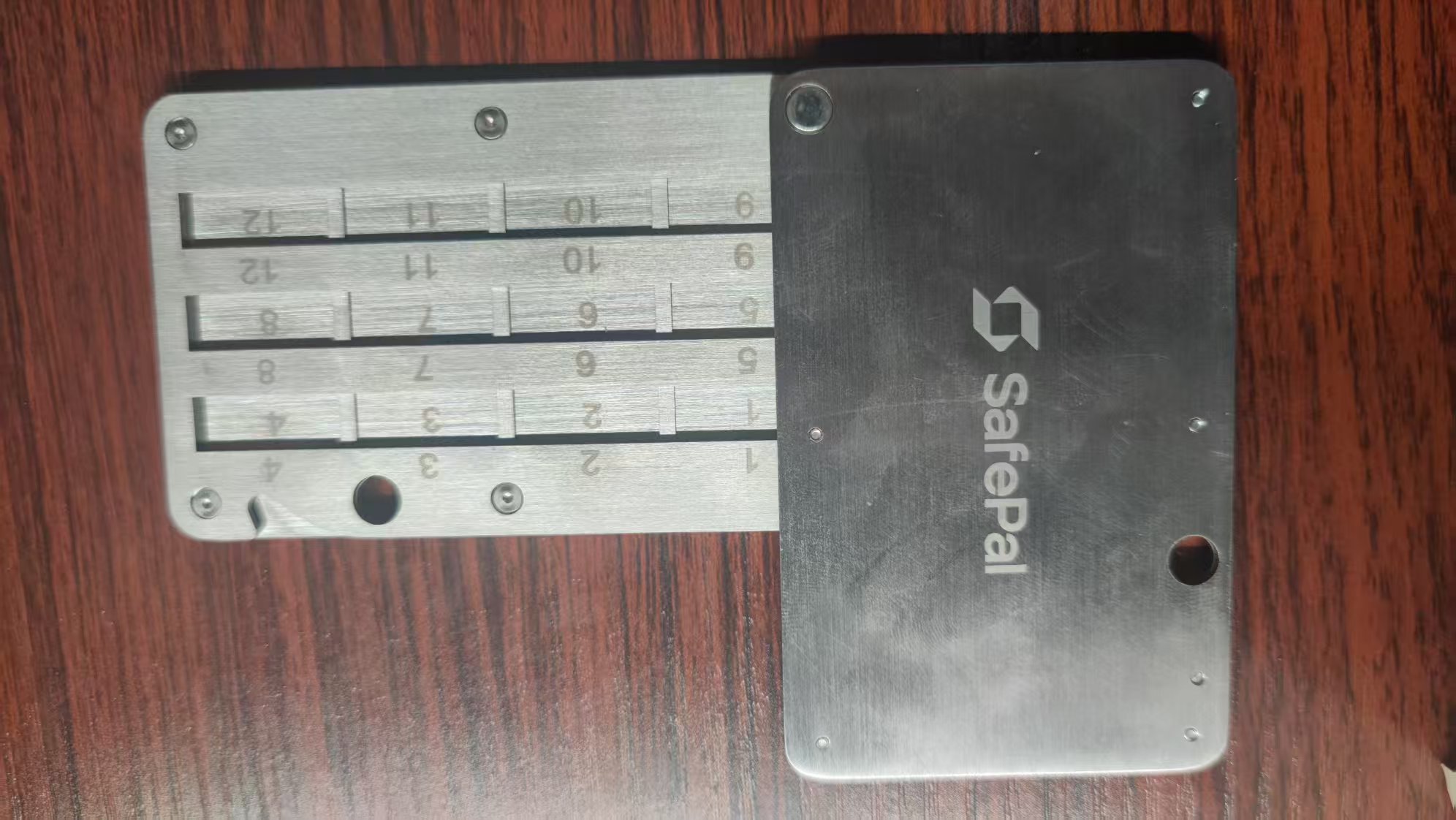
SafePal 官方推出的皮套保护壳专为硬件钱包定制,具备柔韧耐磨的材质与贴合设计,可有效防止设备在携带过程中遭受刮擦、碰撞,非常适合随身携带和长期出行用户使用。
总的来看,如果你刚入门 Crypto 世界,希望找一个便宜又安全的屯币选择,特别是主要用于长期持有(HODL)资产、不需要频繁链上交互、偏好「彻底断网、全程离线」的资产隔离方案、对价格较为敏感,希望在有限预算内获得高性价比安全体验,那以 SafePal S1 + Cypher + 皮套为基础的冷钱包组合,算是当前市场上既经济又可靠的极佳选择(可参见此处)。
「移动端优先」的全栈架构设计
正如前文所述,不同于大多数依赖 USB 接口连接 PC 的传统硬件钱包,SafePal 的 S1、S1 Pro、X1 三款硬件钱包,自诞生之初便围绕 SafePal App 构建了完整的「移动端优先」交互体系,形成了一种更独特的冷钱包交互模式:
S1 / S1 Pro:通过扫描二维码,与 App 实现离线通信与签名;
X1:通过蓝牙自动连接 App,实现无缝签名;
插件钱包:由 App 发起授权请求(插件端亦支持助记词导入,体验上与 MetaMask 保持一致),打通多端互联。
这一设计与 PC 插线相比,更接近微信扫码登录桌面端的体验:插件发起请求 ➝ App 接收请求 ➝ 硬件钱包完成签名 ➝ 回传链上,这意味着交易流程既安全又灵活,私钥始终不离开硬件设备,也不会直接暴露于联网环境中。
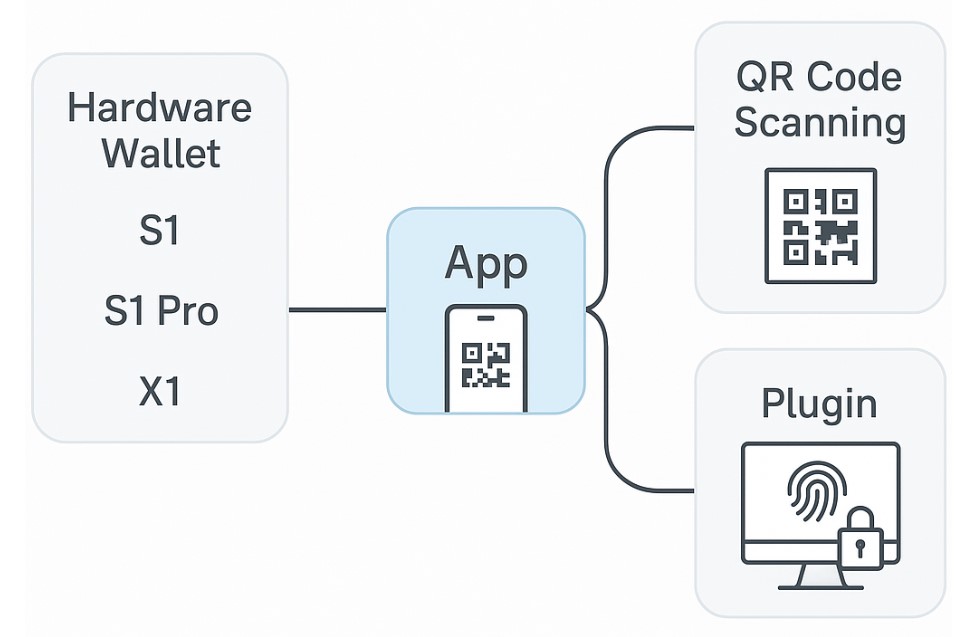
该架构在涉及 PC 插件端钱包的使用场景中,也完全不同于 OneKey 等硬件钱包的互联模式,以最典型的 DeFi 操作场景为例:
传统模式:PC 端钱包进行操作 → 通过 USB 线唤醒硬件设备 → 硬件设备物理确认 → USB 回传数据;
SafePal 架构:PC 端钱包进行操作 → 手机 App 收到推送请求 →S1/S1 Pro 扫码/ X1 蓝牙物理确认 → 加密信道回传数据;
这等于构建了「移动端 App 为核心+硬件安全层+插件端钱包」的三层架构,当用户在 PC 设备的插件端钱包发起交易时,SafePal App 会即时收到推送请求流,通过硬件钱包完成链下签名后再将数据回传插件。
这既保留了插件生态的操作惯性,又通过移动端实现了硬件级安全隔离,笔者认为这种「兼容但不依赖」的设计哲学,也正是「移动端优先」全栈架构的核心优点,本质上是将硬件钱包从「独立设备」转化为「手机生态的安全模块」,实现 SafePal App 一个超级应用打天下(安全交易、资管理财、链上探索):
将移动 App 作为链上交互的真正中心,PC 端则仅承担信息展示和操作辅助的角色,而硬件端则专注于授权与签名,从根本上提升多终端协作时的使用流畅性与安全冗余。
毕竟以互联网时代的发展历程为鉴,未来的 Web3 应用与 Crypto 安全设备,大概率也会围绕移动端重新构建交互逻辑。
结语
硬件钱包级别的 Crypto 安全服务,理应成为一项普惠的 Web3 公共产品。
客观来讲,目前 SafePal 入门款产品 SafePal S1 定价仅为 49.99 美元,作为市面上最友好的入门级硬件钱包,算得上「人人都用得起的硬件钱包」。
而从用户体验的角度来看,随着移动钱包体验的普及,SafePal「以手机 App 端为核心+硬件端二维码/蓝牙签名」的交互模式,也有望逐步成为 Web3 钱包发展的主流范式:PC 端作为操作界面,交易授权和签名则由移动端 App 联动硬件钱包完成,真正实现跨设备、跨场景的一体化资产管理。
从安全的逻辑出发,未来硬件钱包将不再是单一设备,而是一个以 App 为中心的跨终端加密资产管理方案,接下来,期待更多硬件钱包赛道的更多变量。
免责声明:本文章仅代表作者个人观点,不代表本平台的立场和观点。本文章仅供信息分享,不构成对任何人的任何投资建议。用户与作者之间的任何争议,与本平台无关。如网页中刊载的文章或图片涉及侵权,请提供相关的权利证明和身份证明发送邮件到support@aicoin.com,本平台相关工作人员将会进行核查。




